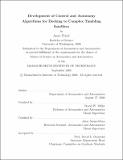| dc.contributor.advisor | David W. Miller and Alvar Saenz-Otero. | en_US |
| dc.contributor.author | Fejzić, Amer | en_US |
| dc.contributor.other | Massachusetts Institute of Technology. Dept. of Aeronautics and Astronautics. | en_US |
| dc.date.accessioned | 2009-08-25T17:59:53Z | |
| dc.date.available | 2009-08-25T17:59:53Z | |
| dc.date.copyright | 2008 | en_US |
| dc.date.issued | 2008 | en_US |
| dc.identifier.uri | http://hdl.handle.net/1721.1/46369 | |
| dc.description | Thesis (S.M.)--Massachusetts Institute of Technology, Dept. of Aeronautics and Astronautics, 2008. | en_US |
| dc.description | This electronic version was submitted by the student author. The certified thesis is available in the Institute Archives and Special Collections. | en_US |
| dc.description | MIT Institute Archives copy: with DVD; divisional library copy with no DVD. | en_US |
| dc.description | Includes bibliographical references (p. 171-173). | en_US |
| dc.description.abstract | The capability of automated rendezvous and docking is a key enabling technology for many government and commercial space programs. Future space systems will employ a high level of autonomy to acquire, repair, refuel, and reconfigure satellites. Several programs have demonstrated a subset of the necessary autonomous docking technology; however, none has demonstrated online path planning in-space necessary for safe automated docking. Particularly, when a docking mission is sent to service an uncooperative spacecraft that is freely tumbling. In order to safely maneuver about an uncontrolled satellite, an online trajectory planning algorithm with obstacle avoidance employed in a GN&C architecture is necessary. The main research contributions of this thesis is the development of an efficient sub-optimal path planning algorithm coupled with an optimal feedback control law to successfully execute safe maneuvers for docking to tumbling satellites. First, an autonomous GN&C architecture is presented that divides the docking mission into four phases, each uniquely using the algorithms within to perform their objectives. For reasons of safety and fuel efficiency, a new sub-optimal spline-based trajectory planning algorithm with obstacle avoidance of the uncooperative spacecraft is presented. This algorithm is shown to be computationally efficient and computes desirable trajectories to a complex moving docking port of the tumbling spacecraft. As a realistic space system includes external disturbances and noises in sensor measurement and control actuation, a closed-loop form of control is necessary to maneuver the spacecraft. Therefore, several optimal feedback control laws are developed to track a trajectory provided by the path planner. Performance requirements for the tracking controllers are defined for the case of two spacecraft docking. With these requirements, the selection of a controller is narrowed down to a phase-plane switching between LQR and servo-LQR control laws. | en_US |
| dc.description.abstract | (cont.) The autonomous GN&C architecture with the spline-based path planning algorithm and phase-plane controller is validated with simulations and hardware experiments using the Synchronized Position Hold Engage and Reorient Satellites (SPHERES) testbed aboard the International Space Station (ISS). Utilizing the unique space environment provided by the ISS, the experiment is the first in-space demonstration of an online path planning algorithm. Both the flight and simulation tests successfully validated the capabilities of the autonomous control system to dock to a complex tumbling satellite. The contributions in this thesis advance and validate a GN&C architecture that builds on a legacy in autonomous docking of spacecraft. | en_US |
| dc.description.statementofresponsibility | by Amer Fejzić. | en_US |
| dc.format.extent | 173 p. | en_US |
| dc.language.iso | eng | en_US |
| dc.publisher | Massachusetts Institute of Technology | en_US |
| dc.relation.requires | System requirements: Adobe Acrobat Reader, DVD reader. | en_US |
| dc.rights | M.I.T. theses are protected by
copyright. They may be viewed from this source for any purpose, but
reproduction or distribution in any format is prohibited without written
permission. See provided URL for inquiries about permission. | en_US |
| dc.rights.uri | http://dspace.mit.edu/handle/1721.1/7582 | en_US |
| dc.subject | Aeronautics and Astronautics. | en_US |
| dc.title | Development of control and autonomy algorithms for docking to complex tumbling satellites | en_US |
| dc.type | Thesis | en_US |
| dc.description.degree | S.M. | en_US |
| dc.contributor.department | Massachusetts Institute of Technology. Department of Aeronautics and Astronautics | |
| dc.identifier.oclc | 422511165 | en_US |
